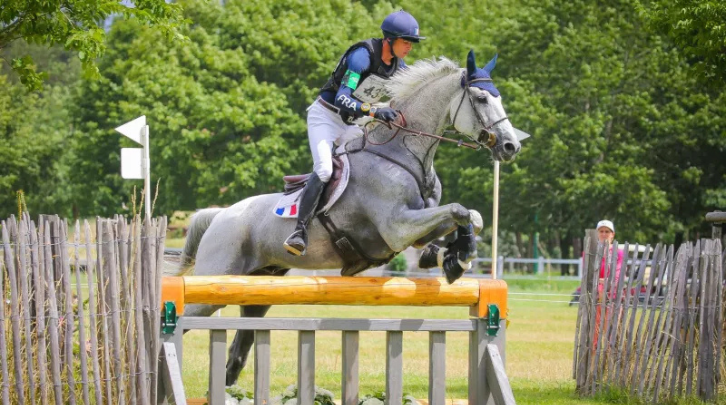In the eventing world, the quest for performance relies on a balance between equestrian tradition and technological innovation. Maxime Livio, an internationally renowned rider and the number one French eventer, shares his approach to preparing his horses for major competitions such as the Olympic Games.
From the daily routine of Api du Libaire, his lead horse, to cutting-edge technological tools like Equimetre and Equisym, Maxime Livio reveals how data helps him refine his intuition and reach the highest level.
Could you introduce yourself?
My name is Maxime Livio, I am 36 years old. I am an eventing rider, the number one French rider for several years, and currently ranked thirteenth in the world.
Who are your horses for 2024 and what are your objectives with each of them?
The year 2024 was, of course, organized around the Olympic Games. My main horse for this event is Api du Libaire, who has already represented the French team and won several four-star competitions. His season is centered on this objective. Then, I have several horses preparing for five-star events at the end of the year: Caruso, Vegas des Boursons, and a very promising young horse, Enjoy, in training for the future.
Can you tell us about Api and his preparation for the Olympic Games?
I don’t think there’s much that needs to change. The fact that it’s the Olympic Games, a major competition, doesn’t mean we have to disrupt what has been working well for years.
One month before the competition, Api follows a program that includes one gallop per week and two to three specific dressage sessions focused on technique. Between these sessions, he does some trotting and recovery, and before each eventing competition, a gymnastic session and a jumping course.
I don’t jump a lot with my horses, but I believe it’s important, a week or two before the competition, to do a complete course to assess their fitness.
What does a typical day look like for Api?
He starts his day with a meal at 6:45 a.m., followed by 30 to 35 minutes on the walker while we clean his stall. His stall is made of shavings to better manage his respiratory system. Then he goes out for a ride or trotting with my rider.
In the middle of the morning, Api spends about two hours in the paddock before returning for his lunch. After a second session on the walker around 2 p.m., I ride him around 2:30 p.m. After that, he goes back to the paddock for a few more hours before his care, which varies depending on the day (osteopath, masseuse, or treatments with machines like Game Ready or Winback).
What role does your veterinary team play?
We work with three veterinarians with specific skills. Suzanne Bougard-Brachet, our general veterinarian, is based nearby. Olivier Geffroy, a locomotion specialist, collaborates closely with our farriers to optimize the alignment and well-being of the horses’ backs. Finally, Julie Dauvillier, a specialist in internal medicine, helps us monitor the horses’ physical condition, particularly through regular examinations of their respiration and heart rate.
On the nutrition side, we work with Lambey. Their nutritionists come regularly to adjust the rations and ensure that the horses are in perfect shape without excess weight, which could harm their performance and health, especially for a large horse like Api.
What do you think about the integration of new technologies in high-level equestrian sports?
The integration of data is essential. Even though our sport is rooted in tradition, we must evolve with the times. However, technology must remain a tool to validate our feelings and help us avoid mistakes.
On the cross-country course, the rider’s intuition is irreplaceable. But to achieve this intimate knowledge of the horse, data is valuable for refining our impressions and validating our choices. It allows us to gain those few detail points that can make a difference at the highest level.
What technologies do you use and why?
For the past 6 to 8 months, I have been using Equisym, provided by the French Riding Federation, to objectively check the horses’ locomotion. It only takes 15 to 20 minutes but allows us to collaborate transparently with the federal staff.
I also use Equimetre, recommended by Julie Dauvillier. This system is simple to use, with a comfortable strap for the horse that records all data via a chip. This data is then accessible via an application that allows for detailed tracking. It enables us to refine our feelings and have constructive exchanges after the sessions.
Can you give us a concrete example where data helped you make a decision?
I had a horse that lacked energy at the end of the course despite having the same preparation as my other horses. By consulting the data, we discovered that he was training at too low a pace to improve his condition. By adjusting the speed and duration of his gallop sessions, his performance significantly improved, and he went on to have a successful career.
How do you see the future of technology in equestrian sports?
Technology should complement the rider’s intuition and knowledge. First, it’s essential to understand the horses, their physicality, and their mentality. Then, technologies can help refine that knowledge and optimize training.
They allow us to enhance the talent of the horses and riders and identify the detail points that can make a difference in high-level competitions.
Keywords: Euimetre, Arioneo, Equisym, Maxime Livio, horse, eventing, Olympic Games, technology, equestrian, data, Enva, veterinarian, equestrian sport.



